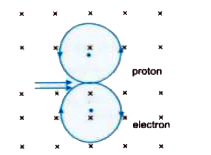An electron and a proton moving parallel to each other in the same direction with equal momentra, enter into a uniform magnetic field which is at right angles to their velocities. Trace their trajectories in the magnetic field.
Both electron and proton (having same momenta) describe circular path of equal as shown in fig.

Topper's Solved these Questions
- MOVING CHARGES AND MAGNETISM BOOK - U-LIKE SERIESCHAPTER - MOVING CHARGES AND MAGNETISM EXERCISE - SHORT ANSWER QUESTIONS
41 Videos
- MOVING CHARGES AND MAGNETISM BOOK - U-LIKE SERIESCHAPTER - MOVING CHARGES AND MAGNETISM EXERCISE - LONG ANSWER QUESTIONS-I
33 Videos
- MOVING CHARGES AND MAGNETISM BOOK - U-LIKE SERIESCHAPTER - MOVING CHARGES AND MAGNETISM EXERCISE - ASSERTION-REASON TYPE QUESTIONS
5 Videos
- MODEL TEST PAPER 3 (UNSOLVED)BOOK - U-LIKE SERIESCHAPTER - MODEL TEST PAPER 3 (UNSOLVED)EXERCISE - SECTION A
3 Videos
- NUCLEIBOOK - U-LIKE SERIESCHAPTER - NUCLEIEXERCISE - Self Assessment Test
10 Videos
Similar Questions
A proton and a deutron having equal momenta enter in a region of uniform magnetic field at right angles to the direction of the field. Depict their trajectories in the field.
View SolutionAn electron and a proton with equal momentum enter perpendicularly into a uniform magnetic field, then
View Solution
Knowledge Check
An electron and a proton with equal momentum enter perpendicularly into a uniform magnetic field, then
AThe path of proton shall be more curved than that of electronBThe path of proton shall be less curved than that of electronCBoth are equally curvedDPath of both will be straight lineAn electron and a proton are moving on straight parallel paths with same velocity. They enter a semi infinite region of uniform magnetic field perpendicular to the velocity.
Which of the following statement(s) is /are true?AThey will never come out of the magnetic field region.BThey will come out travelling along parallel paths.CThey will come out at the same time.DThey will come out at different times.An electron and a proton enter a magnetic field at right angles to the field with the same kinetic energy
AThe trajectory of the electron will be less curvedBThe trajectory of the proton will be less curvedCBoth the trajectory electron will be equally curvedDBoth will move along straight line paths
(a) Derive the expression for the torque on a rectangular current carrying loop suspended in a uniform magnetic field.
(b) A proton and a deuteron having equal momenta enter in a region of uniform magnetic field at right angle to the direction of the field. Depict their trajectories in the field.
View SolutionA proton and a deuteron having equal momenta enter in a a region of a uniform magnetic field at right angle to the direction of a the field. What is the ratio of their radius of trajectory?
View SolutionA proton, a deuteron and an α particle having same momentum enter a uniform magnetic field at right angles to the field. Then the ratio of their angular momenta during their motion in the magnetic field is
View SolutionAn electron and a proton are moving on straight parallel paths with same velocity. They enter a semi infinite region of uniform magnetic field perpendicular to the velocity.
Which of the following statement(s) is /are true?
View SolutionAn electron and a proton are moving on straight parallel paths with same velocity. They enter a semi infinite region of uniform magnetic field perpendicular to the velocity.
Which of the following statement(s) is /are true?
View Solution
